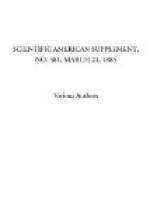The city of Holyoke, another great cotton center, having 23,000 inhabitants, is in some respects the most remarkable town in the State of Massachusetts. It was brought into existence, 35 years ago, by the construction of a great dam across the Connecticut River; and, around the water power thus created, mills have sprung up so rapidly that the population, whose normal increase is eighteen per cent. every ten years in Massachusetts, has doubled, during the last decade, in Holyoke. But eighty out of every 100 persons in the city are of foreign extraction, the prevailing nationality being French-Canadian, a people who are so rapidly displacing other operatives, even the Irish themselves, in the manufacturing centers of New England that they must not be dismissed without remark.
The Canadian-French were recently described in a grave State paper as a “horde of industrial invaders,” and accused of caring nothing for American institutions, civil, political, or educational; having come to the States, not to make a home, but to get together a little money, and then to return whence they came. The parent of these immigrants is the Canadian habitan, a peasant proprietor, farming a few acres, living parsimoniously, marrying early, and producing a large family, who must either clear the soils of the inclement north, or become factory operatives in the States. They are a simple, kindly, pious, and cheerful folk, with few wants, little energy, and no ambition; ignorant and credulous, Catholic by religion, and devoted to the priest, who is their oracle, friend, and guide in all the relations of life. Such are the people—a complete contrast with Americans—who began, some twelve years ago, to emigrate to the mills of New England. They came, not only intending to return to their own country with their savings, but enjoined by the Church to do so. Employers, however, soon found out the value of the new comers, and Yankee superintendents preferred them as operatives before any other nationality, not only on account of their tireless industry and docility, but because they accepted lower wages, and kept themselves clear of trade-union societies. Thus, finally, it has come about that nearly 70 per cent. of the cotton operatives at Holyoke are of French-Canadian origin, and the social condition of all these people is precisely similar to that which has already been described as characterizing the inhabitants of “Little Canada” in Lowell.
It has already been said that the average rate of inhabitancy is six persons per house in the State of Massachusetts, but the presence of the French in Holyoke actually doubles the inhabitancy of the whole town, with what effect upon their own special quarter may easily be imagined. Probably nowhere in Europe could there be found more crowded houses, and worse physical conditions of life, than in the quarters inhabited by certain alien operatives in many manufacturing towns of the United States.




